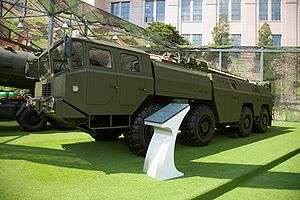WS2400
The WS2400 is a 8x8 special heavy-duty truck developed and built by Wanshan Special Vehicle and used by the People's Liberation Army of the People's Republic of China as a transporter erector launcher platform and is a reverse engineered version of the MAZ-543 missile Transporter erector launcher.[1]
| WS2400 | |
|---|---|
 A DF-11 TEL vehicle, based on the WS2400. | |
| Type | 8×8 heavy strategic truck/transporter erector launcher |
| Place of origin | China |
| Service history | |
| Used by | PLA Rocket Force |
| Production history | |
| Designer | Wanshan Special Vehicle |
| Manufacturer | Wanshan Special Vehicle |
| Specifications | |
| Mass | 19 t (empty) |
| Length | 11.44m |
| Width | 3.05m |
| Height | 2.97m |
| Crew | 1+7 |
| Engine | Deutz diesel 517 hp (386 kW) |
| Payload capacity | 22 tons |
Operational range | 650 km (404 mi) loaded |
| Maximum speed | 75 km/h (47 mph) |
Description
A TEL that is widely used by the PLA due to the sheer numbers of Chinese SRBM assets. The WS2400 is one of the principle mobile workhorse/platforms in mounting and firing China's short-range ballistic missiles.
Wanshan Special Vehicle (湖北三江航天万山特种车辆有限公司) is a wholly owned subsidiary of China Aerospace Sanjiang Space Co. Ltd (中国航天三江集团), which is in turn a subsidiary of China Aerospace Science and Industry Corporation (CASIC)]. The advantage of the WS2400 compared to the MAZ is that it utilizes a German diesel engine, transmission and hydraulics manufactured by Wanshan in China, built using technologies transferred from ZF Friedrichshafen and Allison Transmission.
The WS2400 has a maximum payload capacity of 22 tons, as such, it is used as the base for a number of conventional and ballistic missile systems the DF-11 SRBM and A-100 MRL platforms.
The much larger WS2500 and WS2600 is a more developed evolution of the WS2400 meant to carry MRBMs and IRBMs.
Variants
See also
- MAZ-7310
- HEMTT
- TA580/TAS5380
- MAN gl
References
| Wikimedia Commons has media related to WS2400. |